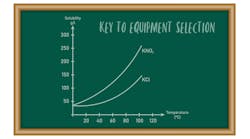Hydrogen has a lot going for it as an energy source. For instance, its abundant and forms only water on combustion. So, its not surprising that the concept of a hydrogen economy has generated a lot of ballyhoo. Turning the concept into reality, however, requires overcoming a host of challenges including ones posed by gas storage and transportation. Two recent developments circumvent the latter issues by employing solids to provide on-demand supplies of the gas. A professor in the U.S. has come up with a technique for generating hydrogen by the reaction of water and an aluminum alloy while researchers in the U.K. have developed a new adsorbent for it.
The reaction of water with aluminum yields hydrogen and alumina, notes Jerry Woodall, a professor in the electrical and computer engineering department at Purdue University, West Lafayette, Ind. Unfortunately, aluminum forms an oxide layer on its surface that hinders the reaction. So, Woodall has developed an alloy made up of 80% aluminum and 20% gallium that avoids the formation of that layer.
Controlled addition of water to a vessel containing the alloy can provide on-demand output of hydrogen, he explains. (See http://hydrogen.ecn.purdue.edu for a video of gas generation.) The product gas is 99+% pure H2 with some water vapor.
Gallium is critical because it melts at low temperature and readily dissolves aluminum, and it renders the aluminum in the solid pellets reactive with water, Woodall stresses.
Gallium now is used mainly by the semiconductor industry and so comes in high purity. Lower-grade gallium would suffice for the alloy and might soon be available at $3-to-$4/lb., which is about a 50th of the cost of the high-purity material, says Woodall. Regardless, the gallium can be easily separated from the alumina by centrifugation and reused, he notes. Recovered alumina can be converted back into aluminum at a cost of about 20¢/lb., an industry specialist recently told him.
I dont see any economic barrier at this point in time, Woodall says. He reckons that such a system hooked up to a conventional internal-combustion engine adapted to run on hydrogen could power a Ford Taurus for 350 miles for about $70. Right now, its in the ballpark for being competitive with gasoline.
The hydrogen-generating technology also could be paired with advanced fuel cells as they emerge, to replace lead-acid batteries in applications such as golf carts, electric wheel chairs and hybrid cars, he adds.
The alloy pellets used so far range from about one to several cubic inches in size. Efforts over the next eight months will focus on finding the sweet spot of alloy composition, pellet size and temperature of reaction, notes Woodall. Later, attention will turn to how to utilize the heat generated by the exothermic reaction.
AlGalCo LLC, West Lafayette, Ind., a startup company in which Purdue has a stake, has exclusive rights to commercialize the technology. The company reportedly is initially targeting standby generators for individuals at home who depend upon medical devices or refrigerated medical supplies in Indiana, a power utility must provide backup power for such people and so might see such generators as a low cost way to meet that obligation, explains Woodall. A prototype generator for supplying 1kW for several hours may be ready by September, he expects. It will contain two tanks, one for water and one for the reaction. If the prototype proves itself, manufacture of commercial generators should begin by next summer. Electric golf carts may be the next application, Woodall adds.
The greatest challenge, notes Woodall, isnt the hydrogen-generation technology but the necessary infrastructure for regenerating and supplying the alloy.
Meanwhile, a team of researchers from the University of Birmingham, Birmingham, U.K., Oxford University, Oxford, U.K., and the Rutherford Appleton Laboratory, Didcot, U.K., working under the auspices of the U.K. Sustainable Hydrogen Energy Consortium, have developed a lithium compound that adsorbs hydrogen and releases it upon demand at relatively low temperature.
The material, Li4BN3H10, which has some structural resemblance to lithium amide, seems to start to release hydrogen at around 150°C, says Martin Jones, director of research for the group at Oxford working on the project. This is far lower than the temperature required for release from lithium hydride (>700°C) and isnt much higher than the around 100°C at which a proton exchange membrane fuel cell operates, he notes.
This could be a major step towards the breakthrough that the fuel cell industry and the transport sector have waited for, says Peter Edwards, project coordinator and a professor at Oxford. The compound, of course, also could be used as a as a source of fuel for internal-combustion engines or for other fuel cell applications, adds Jones. Since the fuel cell is extremely scalable it can be used in small applications like mobile phones and laptop batteries and large applications such as combined heat and power or emergency power backups for hospitals, etc . Where a fuel cell is used and requires an independent source of fuel, the storage material Li4BN3H10 could potentially be of use, he says.
Providing a 300-mile driving range for a car using a fuel cell would require 5 kg of hydrogen (to provide 56,000 liters of gas), he reckons, which translates to 45 kg of the loaded compound. The material acts as a one shot store, much like a battery. The material would be loaded into the car in a fully hydrogenated form , he explains. As for loading it into a car, this is all supposition, but we could imagine a cartridge system like a laser printer or something similar.
So far, the researchers have produced only laboratory-scale quantities of Li4BN3H10. Work on the material should take another three-to-five-years, to optimize hydrogen desorption, scale up to demonstration size, etc., Jones estimates. He adds that fuel cell makers already are collaborating on the development.

